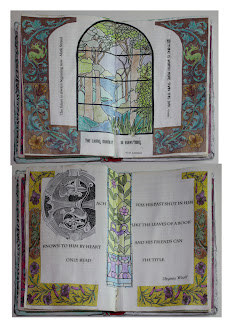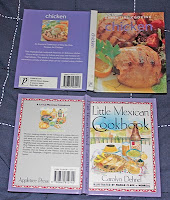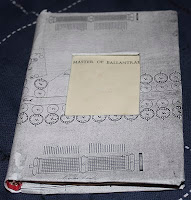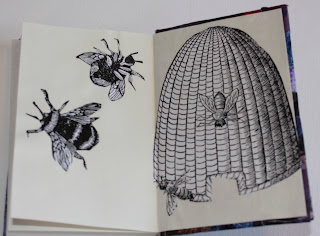Well I am not art journalling every day as I hoped
- unrealistically of course! :(
- but I am doing a lot of work on journals
so Art Journal Every Day has definitely been an inspiration
I have just done a swap on
www.atcsforall.com on altered journal covers so this has finally got me into the world of altered books, something I have been planning for ages.
For this swap the books could be no more than 6” x 6” maximum (approx 15 x 15 cms) so I went to local charity shops and found a couple of tiny hardback recipe books and some old hardback novels. No valuable first editions!
Books to alter have to have stiff covers and must have stitched sections in the spine - not glued, as this technique won’t work with glued spines. If you look down the spine you can check to see that the pages are stitched in sections known as "signatures", and if you open up a signature in the middle the stitching threads can be seen.
Because the pages will be coated with gesso and then collaged or otherwise written and painted on, about half the signatures need to be removed to accommodate the new thicker pages.
The remaining pages are glued together in twos ( in a novel with very thin pages you need to glue maybe 6 together at a time). I use a mixture of PVA glue, acrylic gel medium and a bit of water to dilute it if it is too thick. I got the recipe from Art Trader magazine's fabulous course on Art Journals - Creative Exploration
and this seems to stick anything to anything, seals down collage without too many bumps and can also be tinted with acrylic paint.
The pages are then coated with several thin coats of gesso to create a good working surface. I used greaseproof paper under the backs of the pages I was gessoing to keep the gesso under control and I left it there while the pages dried. The first gesso I used remained tacky and people on the swap site said they would never dry properly so I stuck those pages together and I bought new and more expensive gesso which did dry without stickiness. I think the important thing is to use several thin layers and to let them dry completely between coats - however impatient this makes you (it certainly made me!). I was also advised to try talcum powder (which I didn't - so am not sure how that would work but it would probably be good) and/or to use greaseproof paper between the leaves after they dried - which I did do just for peace of mind as the pages do seem to be completely dry and not tacky at all.
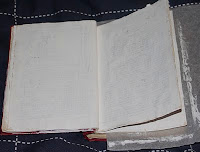

The covers are then ready to be decorated to taste before you start journaling. In the recipe books the pages were quite thick so that they could be written on directly but the novel pages are thin and quite bumpy because of the way they dried, so I will have to collage over those.
The recipe books became the House Book and the Flying Duck Book.
I used a mixture of collage and embellishments with ribbons and keys.
The flying ducks were on an old birthday card and I found bird images to stick inside (on the thick page that resulted from gluing the old non drying gesso pages down!) and I collaged the inside covers back and front.
For the house book used a little house I had drawn and stuck it on the cover and I added a cat inside the opening door and some old keys on black ribbon


Another little book has an insert cut into the cover for a doll's face and was covered in a print of the original Babbage computer. The original was a bit wonky! So I cheated and collaged extra elements on to straighten it all up.
Ready made books can also have their covers personalised
in preparation for art journaling.
I found some little sketch books and autograph books to decorate.
One little sketch book became "Bee is For Book". I collaged the covers and gave them a purple wash of thin acrylic paint, then added some bee images and cut out fonts from Dover clip art books. I added bee images inside the front and back covers and a random bee inside the sketch book for a surprise.
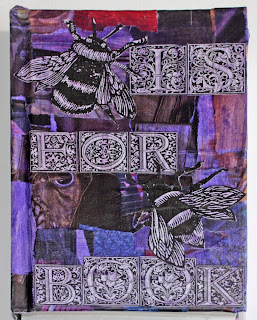
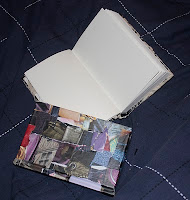 |
| this is the collaged book before the acrylic wash was added |
I covered the other with lace and added old lace bobbins
And a little autograph book became this Phrenology notebook; I used a torn paper background and image transfers of heads and hands (as described in the Shadow Box Workshop notes)
Some of these have been swapped out but I hope to post on what goes inside the ones I still have!
© 2011 Shirley Bell redplantlady
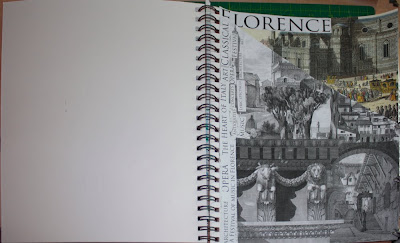

 I am doing a kind of family history journal and I had left stuff out....
I am doing a kind of family history journal and I had left stuff out....










